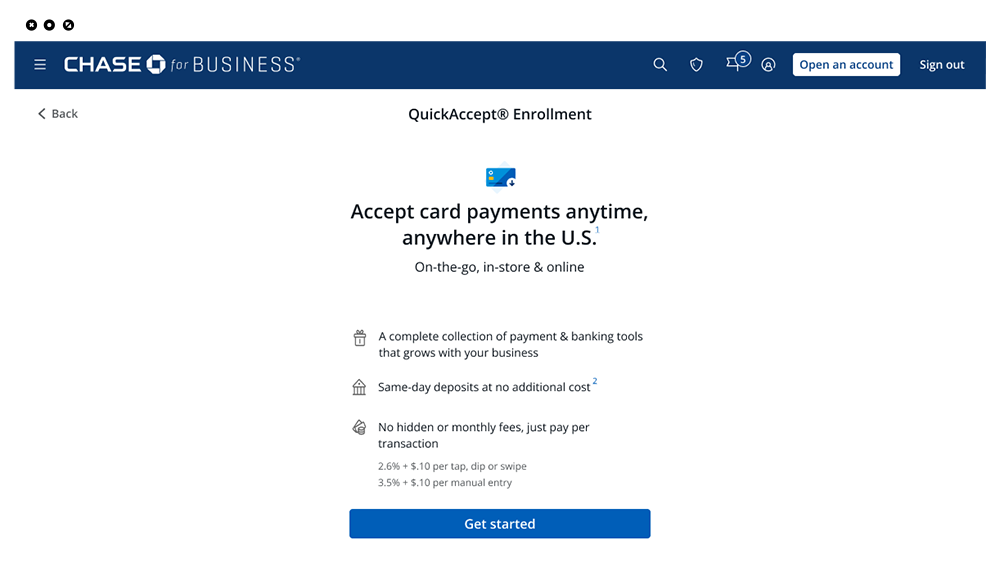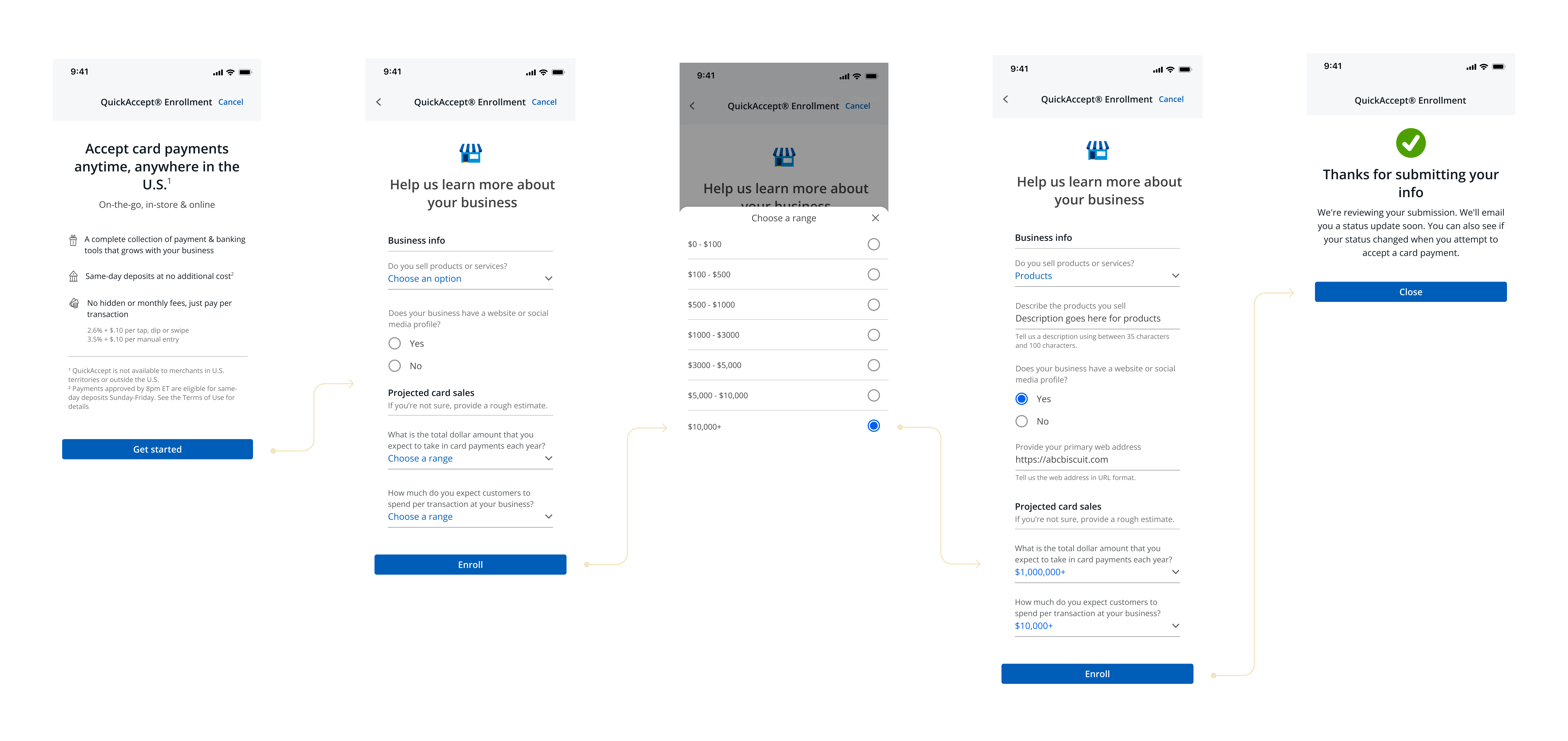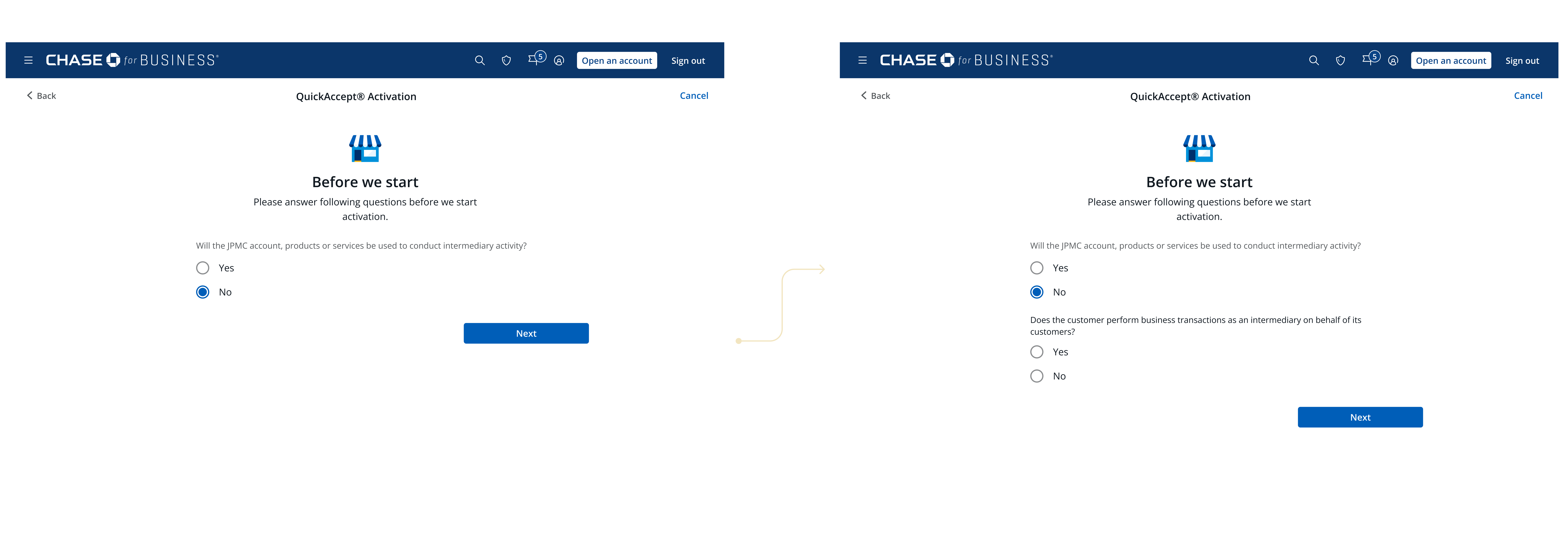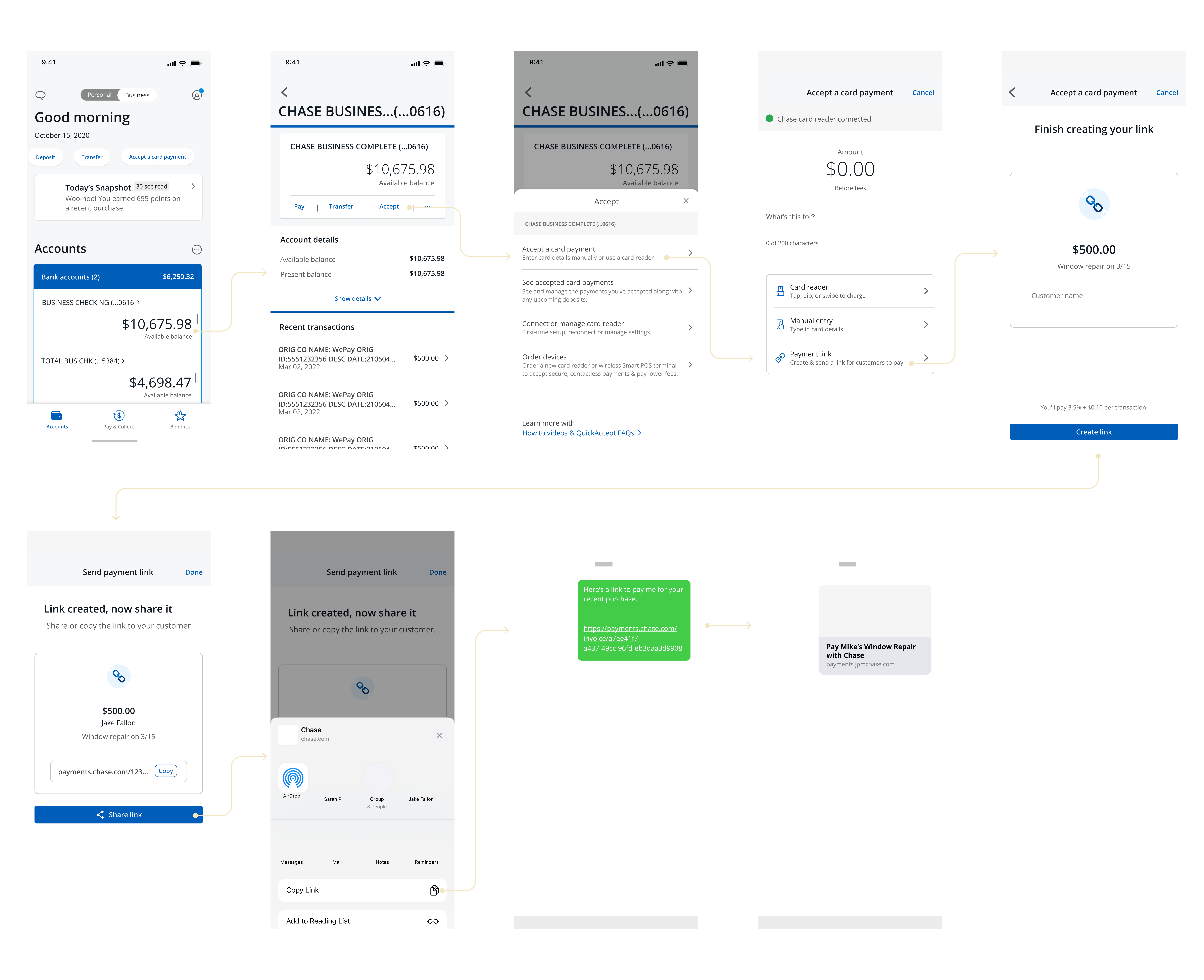As Business Banking VP Design Lead at JP Morgan Chase, I drove the end-to-end UX strategy for QuickAccept onboarding and KYC, leading research, journey mapping, and cross-team alignment to deliver a simpler, trusted, and faster experience for small business customers.
My Role
This is an ongoing project currently piloting with selected businesses. Stay put for metrics and design takeaways!
Project activities

Transforming Onboarding and KYC for Chase QuickAccept®
Project Overview
Chase QuickAccept® is an integrated payment solution within Chase Business Complete Banking®, enabling small businesses to accept credit and debit card payments quickly and securely — in-person, online, or via mobile — with same-day deposits at no additional cost. However, despite its powerful features, the initial customer experience during onboarding and setup revealed critical gaps, particularly for Small Business Owners (SBOs).
The Challenge
The SBOs' journey into QuickAccept highlighted significant pain points:
- Overwhelming Options: First encounters with payment solutions were confusing due to a lack of simple guidance on choosing the right product.
- Complex Decision-Making: Technical jargon like “QuickAccept” and “interchange pricing” created friction at critical sign-up moments.
- Disconnect Between Accounts: Difficulty understanding how merchant services integrated with existing Chase business accounts undermined trust.
- Onboarding Gaps: Lack of intuitive pathways post-approval left users unsure how to find or activate QuickAccept features.

Solution Process
Stakeholder and Leadership Alignment
To align Chase’s business objectives with the real-world needs of Small Business Owners (SBOs), I facilitated a series of Sailboat Workshops with stakeholders and senior leadership. This metaphor-driven exercise provided a structured yet creative environment to surface diverse perspectives, identify misalignments, and collaboratively chart a course forward.
Stakeholders & SBOs Challenges
Personalization and Leveraging Existing Data
- Stakeholder View: Focused on personalizing onboarding, but mainly for operational efficiency.
- Customer View: Frustrated by being asked for information Chase already had.
Transparency in Processes and Decision-Making
- Stakeholder View: Emphasized transparency but leaned toward compliance-heavy communication.
- Customer View: Wanted direct, plain-language updates on application status and product features.
Workshop Key Insights
Personalization and Leveraging Existing Data
- Wind: Stakeholders recognized the value of personalizing onboarding experiences to enhance customer satisfaction.
- Anchor: Customers expressed frustration over redundant information requests, especially when data was already available within Chase systems.
- Rock: Risk of diminished trust due to perceived inefficiencies.
- Island: A streamlined, personalized onboarding process that respects existing customer relationships.
Transparency in Processes and Decision-Making
- Wind: Stakeholders emphasized the importance of transparent communication regarding fees and requirements.
- Anchor: Customers desired more detailed information about application statuses and product features.
- Rock: Misunderstandings leading to customer dissatisfaction.
- Island: Transparent processes that build trust and clarity at every stage.
Outcome
The Sailboat Workshops illuminated the gaps between internal assumptions and customer expectations. By collaboratively identifying these areas, we developed a shared understanding that informed the redesign of the QuickAccept® onboarding experience. This approach ensured that solutions were not only operationally feasible but also deeply empathetic to the needs of SBOs.

Design Solutions
1. Existing business relationship onboarding
Clearer flows that reduced time-to-activation by minimizing unnecessary KYC repetition. A more intuitive & efficient application process where merchants can onboard more quickly and errors can be reduced.
Key Improvements:
- Built smarter recognition into the application process to detect existing Chase banking relationships and surface simplified onboarding paths.
- Removed redundant steps where data could be securely reused, reducing manual entry and user frustration.
- Implemented an intuitive, responsive flow that reduced friction, minimized errors (e.g., typographical mistakes), and allowed merchants to activate QuickAccept® faster.
- Introduced contextual tooltips and pre-validation checks to catch common input mistakes early and avoid costly re-submissions.

2. Acquired business consumer onboarding
Following JPMorgan Chase’s acquisition of First Republic Bank, it became critical to onboard First Republic’s small business clients onto the Chase ecosystem — ensuring a smooth, secure, and trust-driven transition into products like QuickAccept®. Starting onboarding with a Qualifying Questions flow improved client trust and streamlined operations. By pre-qualifying businesses before KYC, we reduced friction, accelerated approvals, strengthened fraud detection, and delivered more personalized onboarding experiences — setting a strong foundation for growth and loyalty.
Key Improvements:
- Reduced friction and confusion for First Republic clients unfamiliar with Chase processes.
- Accelerated approvals by filtering out mismatches and streamlining legitimate applications.
- Strengthened fraud detection early in the journey.
- Delivered more personalized onboarding experiences, building trust at a critical moment.

3. Payment Link Creation Flow Enhancemetns
To increase adoption and usability of the Payment Link feature, we focused on two critical design improvements: enhancing feature discoverability within the QuickAccept® dashboard and simplifying the link creation flow. By making Payment Links easier to find and faster to generate, we reduced user friction, minimized drop-off, and empowered small business owners to request payments more confidently and efficiently.
Enhanced Feature Discoverability
- Redesigned the QuickAccept® dashboard to surface Payment Link options earlier and contextually within payment tasks.
- Introduced visual cues and microcopy nudges (e.g., "Send a Payment Link") at key decision points to increase organic discovery.
Simplified Payment Link Creation Flow
- Reduced the number of taps and screens by consolidating amount entry, service description, and send options into a single, compact form.
- Implemented real-time validation and smart defaults (e.g., pre-filled business name) to minimize user input and cognitive load.

Pilot and Measurement Plan
Following the redesign of the QuickAccept® onboarding and Payment Link experiences, we initiated a controlled pilot launch with a selected group of small business customers, including existing Chase clients and recently acquired First Republic Bank clients.
The pilot incorporates A/B testing across key onboarding and Payment Link flows to measure success against baseline experiences, focusing on activation rates, completion times, payment link usage, and customer satisfaction.
Early metrics and qualitative usability feedback will guide iterative refinements before broader rollout. We expect to release initial performance results and implement the first wave of design optimizations in the coming months, ensuring the final experience is data-driven, user-validated, and scalable.
Other JP Morgan Projects I am invoved with
Consumer Banking Certificates of Deposit
Redesigned the in-branch CD activation flow to create a hybrid banker-client experience. Integrated digital tools and human touchpoints to reduce friction, modernize account setup, and enhance client satisfaction.
Branch-Connected Experience for Business Banking
Led a cross-functional initiative connecting Salesforce, banker tools, and account activation systems. Streamlined data collection and onboarding, reducing activation time and improving the client experience.
SecureBusiness Banking eCoupons
Led the design of a secure eCoupon validation system for business clients, addressing challenges with third-party server authentication and complex error scenarios. Implemented robust error handling and user-friendly interfaces to enhance reliability.
TOP

